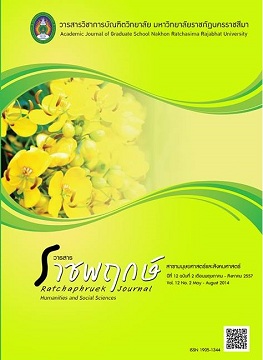An Analysis of English Textbooks Used in Lower Secondary Schools in Cambodia
Main Article Content
Abstract
The objective of this study was to analyze English textbooks for lower secondary schools in Cambodia. The research sample was English for Cambodia Textbook Grade 9. Content Analysis was used to find out the features which were grammar structures, vocabularies, discourse types, socio-cultural aspects, and communicative functions. The finding revealed that tense was the most frequently grammar structure found (55.02%), followed by modal auxiliary verbs (17.1%). Noun wasthe highest frequent part of speech used in textbooks (54.16%), followed by verb, adjective, and adverb (28.33%, 15.27%, 2.22% respectively). For discourse types, dialogues and passages were the most used (45.24%), followed by letters (7.14%) and postcards (2.38%). For Socio-cultural aspects, social aspect wasthe most frequent text found (90.33%), followed by cultural aspects (9.67%) and most of the socio-cultural aspects involve Cambodian customs and traditions. The most frequent type of communicative function was requesting (18%) followed by greeting (16%), questioning (16%), and suggesting (4%). Three activity types were used in the textbook. The most frequent one was meaningful activity (41.92%) followed by mechanical activity (40.55%), and communicative activity (17.53%). The media attached to textbook composed of pictures (77.61%), and audio recordings (22.39%).
Article Details
References
Celce-Murica, M. (2001). Teaching English as a Second or Foreign Language. 3rd ed. United State of America : University of California.
Cunningsworth, A. (1995). Choosing your coursebook. Oxford : Heineman.
Graves, K. (2000). Designing Language Course: A guide for teacher. Boston, MA : Heinle and Heinle.
Immauel, V. (2010). “The Role of Material In a Language Classroom”. Anti Essays. Cambridge : Cambridge University Press.
James, F. L. and V. Bill. (2003). Making Communicative Language Teaching Happen. 2nd ed. New York : San Francisco, St. Louis.
Karens, I. and B. Anne. (2002). Multimedia Projects in Education : Designing, Producing, and Assessing. 2nd ed. Libraries Unlimited : A Division of Green wood Publishing Group
Paulson, D. L. (1972). “Structural pattern drills : A classification”. In H. Allen & R. Campell. Teaching English as a second language. New York : McGraw-Hill.
The MoEYS. (2004). Policy for curriculum development 2005-2009. Ministry of Education Youth and Sport, Cambodia.
CamTESOL. (2009). Conference on English Language Teaching : Selected Papers. Ministry of Education Youth and Sport. Cambodia.
Tomlinson, B. (1998). Glossary of basic terms for materials development in Language teachingand introduction. In Tomlinson B. ed. Materials development and language teaching, Cambridge University Press.
Wilson, C. (1999). Using picture in EFL and ESL classrooms. Paper presented at the current trends in English Language Teaching Conference, Abu Dhabi, United Arab Emirates.


